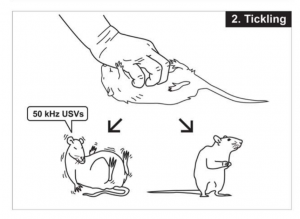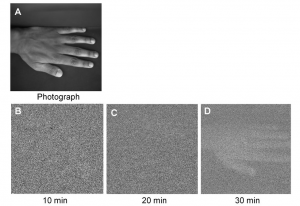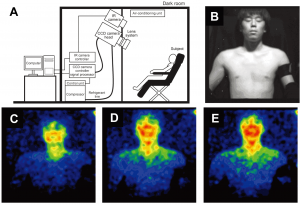Secret Communication in Nature Part II: Animals!
 Welcome to Part II in our series on Secret Communication In Nature — hopefully you’ve already enjoyed Part I, and hopefully you aren’t eagerly expecting Part III because we basically cover everything in these two parts. But what do I mean by “secret communication in nature”? Well, if the scent of freshly mown grass brings back delightful childhood memories, you’re waxing nostalgic inside a giant cloud of distress signals emitted by wounded plants. That smell is their screams, you monster. Hopefully you’ve come to terms with this horror already after reading Part I. Here, we’ll focus our attention on the animal (and microbial) kingdom — for example, animals that emit sounds outside the range of human hearing, microbial fireflies, or the geological (and galactic) significance of poop.
Welcome to Part II in our series on Secret Communication In Nature — hopefully you’ve already enjoyed Part I, and hopefully you aren’t eagerly expecting Part III because we basically cover everything in these two parts. But what do I mean by “secret communication in nature”? Well, if the scent of freshly mown grass brings back delightful childhood memories, you’re waxing nostalgic inside a giant cloud of distress signals emitted by wounded plants. That smell is their screams, you monster. Hopefully you’ve come to terms with this horror already after reading Part I. Here, we’ll focus our attention on the animal (and microbial) kingdom — for example, animals that emit sounds outside the range of human hearing, microbial fireflies, or the geological (and galactic) significance of poop.
Some might accuse me of rushing to publish this second article in our series a scant 2 years after the first one. “How could you have possibly produced such an excellent article in only 24 months??” they’d shout incredulously. And yet, I did. No, this blogger will not wait the customary 8 years between posts, for that would be a great disservice to the dozens of you readers out there! So enjoy, and I’ll see you again in 24 months!
Infrasonic Elephants
Most people can do a decent imitation of an elephant’s trumpeting call (though the folks in this library don’t seem to be a fan), but did you know about other sounds they make? They don’t bother with the trunk-up-let-it-fly hollering when just conversing with each other — when talking amongst others in a herd, for example, they use a different type of call that we can’t hear at all. In fact, if you visit the elephant enclosure at the zoo, chances are they’re talking smack about you right to your face, without you noticing.
In fact this is how the communication was discovered — Katy Payne, a scientist, was observing elephants at the San Diego Zoo in the ’80s, and felt (as opposed to heard) a rumble in the air, and suspected she might be hearing infrasonic calls being made by the elephants. You don’t hear infrasonic sounds (hence the “infra”) — but you can feel them if they’re loud enough, which is how Payne noticed them. Sometimes we can hear the high harmonics of these calls, if they are high enough to be in our range of hearing — but their fundamental frequency is still well below our ability to hear.
We know from physics that the lower the frequency of the sound, the farther it can travel without being absorbed. Hence you can hear the booming bass of DJ Magic Mike (‘Ain’t No Doubt About It’) from the car out in the street, even when you’re in your house on the crapper, but you can’t hear the funky hi-hat unless you’re out near the car. Well, elephant infrasonic calls make DJ Magic Mike sound like Alvin and the Chipmunks — the sub-20-Hz frequencies can travel for miles in the forest, especially at night when the air is still. So it turns out to be a good way to communicate with members of the herd who might be a half-mile away, far out of direct eye contact in the thick forest. Higher frequencies, in contrast, get attenuated more quickly by forest foliage. Elephants, with their large larynxes, are one of the few animals who could evolve to take advantage of this.
Later, Caitlin O’Connell-Rodwell has showed that elephants also use seismic communication — they can “hear” low-frequency vibration traveling through the ground as seismic waves, via their feet and trunks. Sometimes it’s a way to better hear the infrasonic calls emitted by other elephants, sometimes it appears to be to listen in on the movement of the herd (e.g. running), other times they’re actually listening in on bigger natural events much further away — like rain, thunder, or even tsunamis. Back in 2004, elephants seemed to know something bad was about to happen well before humans detected the gigantic tsunami — the elephants shrieked and bolted for higher ground, saving the lives of handlers and tourists who followed them (without knowing the reason).
Further reading: Katy Payne and The Elephant Listening Project (and their YouTube channel), Caitlin O’Connell’s research team
Ultrasonic Tarsiers
So elephants communicate at sound frequencies lower than we can hear, what about frequencies higher than we can hear? Turns out yes – certain animals communicate in ultrasonic frequencies. Ultrasound (the ultraviolet light of audible phenomena), starts at 20 kilohertz, just about the upper limit for humans. (Well, young humans.) It’s well known that bats use ultrasonic echolocation for finding prey, and many animals (dog & cats for example) can hear ultrasonic sounds that we can’t. But it turns out that someone in the primate category can emit ultrasonic calls for communication.
The story is much like that of the elephant – observant scientists spot clues of communication in seemingly silent animals, wonders if there’s more to the story, and confirms their suspicion using some fancy microphones. Particular species of Tarsiers (Tarsius bancanus and syrichta) were observed to be basically silent, but given other species are pretty talkative, Carsten Niemitz wondered if they were communicating in a way we couldn’t hear, e.g. in ultrasound. In fact they sometimes looked like they were calling, but no sound was coming out. Nathaniel Dominy and his team confirmed the suspicion by dragging some ultrasonic-capable recording equipment out to the jungle. Certain calls were audible but had harmonics up in the ultrasound, while others were entirely ultrasonic and so completely inaudible to us.
But why? Screaming up in the ultrasound could be a way to communicate secretly, without tipping off predators or prey – in some cases, the Tarisers recorded by Dominy’s team amped up the ultrasonic hollerin’ when the researchers wandered close. Not to mention the ultrasonic frequency bands are less noisy, so it might be easier to communicate up there, predators or not. Lots of evolutionary advantages are ripe for the picking for the ambitious species willing to modify their vocal cords.

This is an actual figure from an actual scientific research paper. I clearly wasted my research career on the wrong topics.
Or, maybe it’s just for shits and giggles. Well, specifically giggles. (We’ll get to the shit later.) Researcher Jaak Panksepp has discovered that laboratory rats will giggle when humans tickle them, and this laughter is in the ultrasonic range! After all the horrible things done to rats in the name of science, I’m glad to see at least one researcher imparting a little joy for the little buggers. Which you can clearly see from their research article – figure 3 from this paper (shown to the right) is the most charming figure I’ve ever seen in science. While he can’t prove definitively that the rats really are laughing, behavioral tests (described in the paper) show they’re in a happier mind state after a bought of ticklage with their human researcher, and also emit these little ultrasonic laughs when they appear to be playing with each other. Once his lab realized how eagerly their rats appeared to be tickled and played with, the lab’s research focus switched to understanding whether this really could be considered analogous to human laughing and happiness.
Further reading: Primate Communication in Pure Ultrasound (Ramsier, Dominy et. al., Biology Letters 2012)
Dung Beetles, Secret Astronomers
Let’s say you’re a dung beetle. You’re rolling your little ball of poo along the ground, recently carved from a mound of fresh turdage. The poo-ball is pretty large, hard to see around, and you didn’t bring your GPS. How do you make sure you don’t roll the wrong way? You’ve got to get this steaming wad of guano back to your home, and you don’t want to get caught by a predator, nor poo-swoggled by another competing beetle. So you want to make as quick of an exit as you can, not get lost wandering around in circles.
So, what’s the best way to make sure you’re rolling the poo ball in a nice straight line? Hey, you could just look at the sun! Oh wait, you’re a nocturnal insect — no sun. Well… there is the moon! Hmm, are dung beetles smart enough to navigate by the light of the moon? Turns out, yes! This was mildly surprising to me — most of us have probably heard that insects use the moon for navigation (e.g. moths circling a porchlight, thinking it’s the moon), but I still think this is a pretty remarkable bit of intelligence they display. But we’re not done yet — after all, the moon might not be out when you made your haul. What then? As long as it’s not cloudy, the lowly dung beetle still has a trick up its sleeve — not only do dung beetles use the light of the moon to navigate, they’ll switch to using starlight when there’s no moon out. Specifically, they use the Milky Way as a landmark to ensure they’re poo-rolling in the right direction.
The research group that discovered this stunning fact (Eric Warrant at Lund University in Sweden) proved the beetles were able to do this by staging a little poo-rolling session inside a planetarium, where they could precisely control what kind of night the bugs experienced. Hopefully they cleaned up before the Laser Floyd show that night. Even with only the light of the Milky Way, the little buggers could maintain nice straight lines of poo-rolling. However without either the moon or the Milky Way, they wound up wandering around in little circles, where (in the real world) they’d be sitting ducks for predators or other poo-stealing beetles.
Personally I find this fascinating — light reaching earth from extremely distant stars, some of which may not even exist anymore, shines down and helps a little beetle find its way through the night. I’m also personally fascinated with a newly-coined term for this research area: “Chronoastrobiology”.
Further reading: Dung Beetles Use The Milky Way For Orientation, (Dacke et al, Current Biology 2013)
Speaking of Poo…
Every so often we have to land the TimeBlimp and walk our dog. (Pooping over the side while aloft is a bit too dangerous, and got us in a spot of trouble over that suburb in Oregon.) Watching a dog deciding where to poop, it’s as though the dog is trying to line itself up for just the perfect selfie shot. “Wait — like this! No no, more like this! Wait, now like this! OK, here we go…” Why all the rigamarole? Sometimes they circle around and around, seemingly concerned with getting their body aligned just right. Aligned to what? To the Earth’s magnetic field, that’s what!
In a recent paper, scientists measured body alignment in 70 dogs during almost 2,000 deuce-droppings over the course of two years. (“Welcome to grad school! Have I got a great project for you!”) Dogs had a relatively strong preference to drop their kids off at the pool with their bodies oriented North/South, and the effect was strongest when the magnetic field conditions were most stable. And what about peeing, you might ask? Well, females still prefer the North/South axis when they tap a kidney, but males for some reason prefer a Northwesterly heading when they shake hands with the pope. Why does a magnetic field matter so much to a dog, when it has to take the Browns to the Super Bowl? Nobody knows.
Could this be real? Is it statistically significant? The authors claim to have ruled out other possible alignment stimuli, like the possibility the dogs face away from the sun, or into the wind. Personally I would have guessed dogs would aim downwind so they can continue to smell for predators or prey while they’re freeing some chocolate hostages, but apparently the effect is independent of the wind. And we don’t yet have a plausible reason why they would care about magnetic fields. A nice consequence of digging deep into this research is the chance to really think deeply about what my outdoor pooping preferences would be, if the occasion ever came up. (Another great side-effect of this topic is all the targeted internet ads you get while researching it.)
Apparently other species sometimes spontaneously align their bodies with the Earth’s magnetic field, in the absence of any other alignment-inducing stimulus. But these other examples have been on activities like grazing cows and deer — this is the first instance I’m aware of that detected magnetic alignment while beaming down a Shatner. Clearly, the effect on pooping is of much greater interest than the effect on eating. However if I were a prospective magnetoception researcher deciding what topic to do my PhD on, I’d personally choose the grazing-cows niche over the dog-poo niche – you could join these folks who used magnetic fields to disrupt feeding ruminants, for example, if you really want to mess with some herbivores.
So the next time you need to launch the Brown October, try rotating yourself on your porcelain throne to line up with your local magnetic field – you might just like it!
Further Reading: Dogs are Sensitive to Small Variations of the Earth’s Magnetic Field (Frontiers in Zoology 2013)
Meanwhile, on the Molecular Level…
Here’s a question for you, Mr. Smartypants – how do individual cells communicate with each other? No mouth to speak with, no plumage to display, no telegram (cell-egram? HA!), nothing like that. If cells have to speak to one another, how do they do it?
Well, chemically of course – cells emit various substances into their environment which are picked up and sometimes acted upon by nearby cells. For example the exchange of neurotransmitters at the synapse between two neurons. But there’s another theory floating around: do cells communicate with each other using light? The theory says that 1) all individual living cells emit their own light, and 2) the purpose is to send signals to other cells nearby. It’s a pretty cool concept — cells are flashing small faint bursts of light to each other to communicate, like little morse code blinking at the microscopic level. As it happens, it looks like not all of this theory is true. But what’s fascinating is that part of it is true.
Now, we’re not about macroscopic (big) organisms communicating via light (e.g. lightning bugs) here – this theorey is specifically about single cells, and specifically about low-intensity (invisible to the eye, generally unnoticed) light emitted from normal everyday cells. Strong, easily-visible light from multicellular organisms like fireflies or jellyfish is called bioluminescence (and probably deserves its own article – mental note). Bioluminescent organisms — fireflies, jellyfish, those rare fire-elephants that are so resplendent in northern Michigan skies in the summers… wait what? Of course there’s communication going on among fireflies via the patterns in their blinking, but that’s not what I’m talking about here.
You’ve also got yer thermal emission of light, which is emitted by every organism living or dead that happens to be warmer than absolute zero. Everything emits this kind of light, living or dead or whatever – “thermal emission” of radiation is what we see in infrared cameras. We are all glowing like a hot coal, but the glow isn’t visible unless we’re hot enough. But that’s not really how you’d communicate — you can’t change your thermal output without changing your temperature, so not real practical for displaying messages. Maybe some predators use IR to pick up prey, but that’s not what I’m talking about here.

Have you ever really looked at your hands? Like, really looked hard? Like, continuously image for about an hour to detect the extremely faint light emitted by background metabolic chemical reactions in our cells?
Turns out there’s a third source of light being emitted by all living tissue — it’s different than thermal radiation, and it’s not just for fireflies. In fact you’re emitting right now. This light is too faint to see with the eye, but it’s in the visible and ultraviolet range and can be picked up with cameras. A few researchers have recorded this light, though it takes loooong exposure times to pick it up. For example, the image to the right shows some dude’s hand, continuously imaged for 30 minutes in complete darkness to tease out the faint light emitted by his cells (from Towards the two-dimensional imaging of spontaneous ultra-weak photon emission from microbial, plant and animal cells). This light is far too weak to see by eye, unless your eye happens to be capable of averaging together a half-hour’s worth of images.
The general scientific consensus is that this light is accidental or at least unconsciously emitted – it comes from various chemical reactions spitting out photons – particularly “oxidative metabolic processes”. Nobody knows for sure, but the conventional thinking is that occasionally some step in our metabolism goes awry, and instead of converting some food molecule to stored energy (for example), a reaction goes down a “wrong” pathway and emits a photon.
Now, do any organisms use this light intentionally to communicate? Do cells even have the capability of detecting the photons emitted by their neighbors? This paper walks through the possibilities, most importantly: could cells even shine bright enough to be seen if they wanted to? We know that our eyes can just about detect individual photons, but that’s with an entire retina at your disposal. It would be much harder for a single cell. There’s just a ton of background noise to deal with. The authors go through the math of the signal-to-noise ratio expected for typical conditions, and conclude that cells can’t emit enough light to compete against the humongous background noise – maybe in some pitch-black cave, for example, but not under normal sunlit conditions.
So where did this idea come from? Well, imagine (if you will) an experiment. Place two cell cultures near each other in the lab, chemically but not optically separated from each other (e.g. in sealed but transparent containers). Then measure stuff about them as they grow, e.g. growth rate, and you find they’re more similar to each other than you’d expect by chance. Put an optically opaque barrier between them, and the similarity drops down to random-chance level. Experiments like this have been done since Alexander Gurwitsch first tried it in the 1920’s in Russia, finding (he claimed) a “mitogenetic ray” that was emitted from cells and affected cell reproduction. In modern times the terminology has changed to call these emissions “ultraweak” (good to see my nickname from junior high has historical basis).
The overall reaction to Gurwitsch’s work by mainstream science has been 1) huh, cells do emit light, but 2) probably don’t use it for communication. These experiments don’t directly prove any communication is going on; after all, maybe the experimenters didn’t fully chemically isolate the dishes from each other. The reaction from fringe science and pseudoscience has been “Holy BALLS, HEALING RAYS COMING FROM MY PLANTS!!! WHERE’S MY CRYSTAL???” And that’s where I leave this topic — TimeBlimp generally doesn’t delve into pseudoscience, unless it’s to make fun of their terrible webpages.
Further Reading: Towards the two-dimensional imaging of spontaneous ultra-weak photon emission from microbial, plant and animal cells; Cell-to-cell signaling through light: just a ghost of chance?; Imaging of Ultraweak Spontaneous Photon Emission from Human Body Displaying Diurnal Rhythm, (Kobayashi et al, PLoS ONE 2009)
Snakes Smell With Forked Tongue
Snake tongue-flicking is to sample the air – sort of a blend between taste and smell. Instead of inhaling a scent, it catches a scent on the tongue. But it’s not tasting the scent using taste buds on its tongue — instead, the tongue passes the chemical to another sense organ on the roof of the mouth called the Jacobson’s organ, which processes smells for the snake just as the nose processes smells for us humans. (Interestingly, it’s possible that humans also have a Jacobson’s organ though it’s probably vestigial. At least until I get around to doing those Jacobson’s organ exercises.)
So what about the forked nature of the snake’s tongue — why bother having it forked? If you were using your tongue basically as a ladle to get smells to the roof of your mouth, wouldn’t a flat single-lobed tongue be more efficient? Could it be the two tines serve the same role as our two eyes, to enable smelling in 3D?
Kurt Schwenk published an article in Science a few years back proposing that the fork helps snakes smell in stereo. He posits that the two “tines” of the tongue present two different air samples to the Jacobson’s organ (which conveniently has two sides, ready to accept the offering from each tongue tine). The snake’s olfactory system compares the strength of signal between the two tines, and interprets a difference to mean that the emitter of the smell is toward the stronger side. So this helps the snake follow a scent trail — for example, from another snake emitting pheremones, or from prey. In particular the two air samples turn the tongue into an “edge detector” for scent clouds — if one tine no longer picks up the scent, the snake knows to turn towards the other side to stay inside the cloud.
Now you don’t necessarily need a two-pronged tongue to sense gradients in scent intensity (to use the technical jargon) — you could get by with a single tine, and just compare intensities across multiple tongue flicks as you move your head around. Presumably there’s an evolutionary advantage to developing this more sophisticated tongue anatomy so you can sample the smell gradient in a single tongue flick. The evidence in favor of simultaneous sampling (called “tropotaxis”) over sequential sampling (“klinotaxis”) is that if you block one of the tines, snakes become unable to follow a pheremone trail — they start tilting towards the unblocked side constantly, hence just wander around in a circle from that point on. There’s also neurological evidence that the signal from each side of the snake’s Jacobson’s organ travels to the brain and is processed separately, rather than being combined early on — that there’s a “neural circuit” actively comparing the intensity from both sides of the tongue.
The upshot of this, if true, is that the snake can get a sense of the spatial distribution of smell concentration in real time — in other words, they can smell in stereo. Arguably it’s a stretch to call this “stereo smell” — detecting the direction of a smell is a far cry from the spatial distance sensing we can do with stereo vision. But it’s not far off from how we can spatially locate the origin of a sound using our two ears. I gather that not everyone agrees about the evidence for snake tongue tropotaxis, but it’s a clever hypothesis. If you can manage to evolve a two-pronged sensor, you can get information about both what’s emitting the odor, and where it is. Helpful if you’re trying to catch dinner or avoid becoming dinner.
Now that we’re on the subject, why do we humans have two nostrils? Are we capable of some kind of similar stereoscopic smell? Back in the 60’s, Georg von Bekesy showed that humans were capable of smelling in stereo — we do it too! Specifically, the brain compares the stench coming in to each nostril, and concludes the origin based on the timing differences and/or stenchosity difference.
You could do this with just one nostril, of course — just move your head around and compare successsive sniffs for where the stench gets heavier. But there’s evidence that moles, rats, dogs, in addition to us humans, all use our two nostrils to spatially locate the origin of a smell. In this interview, Noam Sobel describes an experiment where human volunteers got on their hands and knees to sniff out a scent trail in a field, helping to demonstrate that two of our two face-holes help us triangulate the origin of a stench. While being a volunteer for science could be worse, it must not have been fun crawling around a field with a nostril taped shut – but otherwise, how would we know the brain expects to use information from each nostril simultaneously?
Further Reading: Why Snakes Have Forked Tongues; Olfactory Analogue To Directional Hearing (Georg von Bekesy); The Forked Tongue and Edge Detection in Snakes






 Follow Timeblimp on Twitter
Follow Timeblimp on Twitter